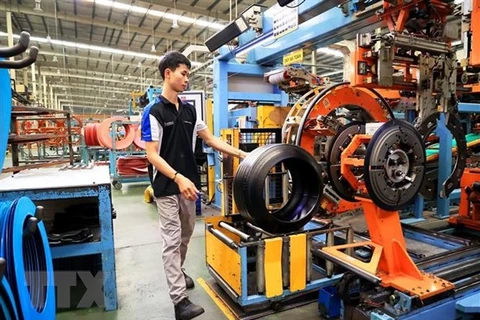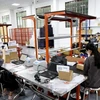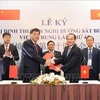Hanoi (VNA) - The Ministry of Industry and Trade sent a report to Deputy Prime Minister Tran Hong Ha on receiving comments on a draft decree amending Decree No. 111 on developing support industries with preferential policies to drive innovation and competitiveness.
In the 2011-2020 period, industry had the highest growth rate among the national economic sectors. It made a contribution of approximately 30% to GDP, and became the country's main export sector. This helped bring Vietnam from the 50th (2010) to the 22nd position (2019) among the world's largest exporting countries.
To date, Vietnam has formed several key industries in the economy. In addition, the process of industrial restructuring associated with innovating growth models and improving labour productivity has increasingly focused on the industrialised core. A support industry ecosystem was initially formed, and the localisation rate increased.
According to insiders, the implementation of the Government's solutions has promoted Vietnam's support industry to develop and improve production capacity to participate in the global production chain.
Pham Tuan Anh, Deputy Director of the Department of Industry under the Ministry of Industry and Trade, said there are currently about 5,000 enterprises operating in support industries. These enterprises supply domestic industry and are exported to several markets around the world. They include electric cables, gearboxes and plastic components, with the main export markets of the Republic of Korea, Japan, China, and the US.
In addition, enterprises in this sector are enhancing their capability through training for management teams as well as applying technological advances to improve production.
According to Anh, the localisation rate of support industry products has improved significantly in recent times. Specifically, in the fields of garment and textiles, and footwear, the rate is about 45-50%, mechanical manufacturing 15-20%, and automobile manufacturing and assembly 5-20%. This rate is higher for some vehicles such as trucks and passenger cars.
Reality shows that support industries have made important contributions to socioeconomic stability. Furthermore, when businesses can produce their own product components, it will help reduce imports, limit the trade deficit, and increase foreign exchange revenue. At the same time, raising the localisation rate reduces production costs and promotes industrialisation.
According to experts, for many years, developing supporting industries is not only a business problem but also a national aspiration to bring "Made in Vietnam" products to the world market.
For example, the localisation rate of many vehicle models supplied by Thaco Truong Hai is up to 70%. Or like VinFast's electric car lines, the localisation rate is 60% from chassis, interior, exterior, the electrical system, automation system, and AI-embedded software.
These things prove that the production capacity of Vietnamese firms fully meets the strict requirements from enterprises, especially FDI companies.
The draft decree amending Decree No. 111 has policies supporting the attraction of both domestic and foreign investments, helping businesses become product suppliers, and supporting human resources training, product research and development, and technology transfer.
A new feature is the provision of interest rate compensation for enterprises producing support industry products. Regarding the list of support industry products, many new products have been added, providing better support for enterprises, Anh said./.
























